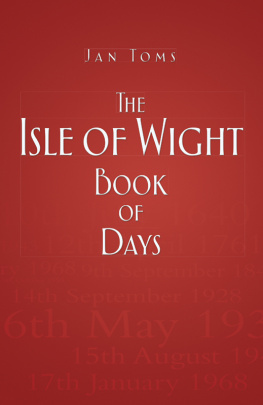
Death In Godshill
An Isle of Wight tragedy
Peter James Cave
Copyright Peter James Cave, December 2012
The moral right of Peter James Cave to be identified as the author of this work has been asserted by him in accordance with the Copyright, Designs and Patents Act, 1988
First published in England, December 2012
Published by Memoirs

25 Market Place, Cirencester, Gloucestershire GL7 2NX, England
Tel: 01285 640485, Email:
www.memoirspublishing.com
Read all about us at www.memoirspublishing.com . See more about book writing on our blog www.bookwriting.co . Follow us on www.twitter.com/memoirs_books
Join us on www.facebook.com/MemoirsPublishing
Book jacket design Ray Lipscombe
ISBN 978-1-909544-07-9
All rights reserved.
No part of this publication may be reproduced, stored in a retrieval system, or transmitted in any form or by any means, electronic, mechanical, photocopying, recording or otherwise without the prior permission of Memoirs.
Although the author and publisher have made every effort to ensure that the information in this book was correct when going to press, we do not assume and hereby disclaim any liability to any party for any loss, damage, or disruption caused by errors or omissions, whether such errors or omissions result from negligence, accident, or any other cause.
The views expressed in this book are purely the authors.
Table of Contents
ACKNOWLEDGEMENTS
The National Archives
Isle of Wight Register Office Hampshire County Council Records Office The Hampshire Chronicle
The Isle of Wight County Press The Isle of Wight Records Office The Isle of Wight History Centre
Air war over the Island by H J T Leal, published by +-The Isle of Wight County Press
A Lance for Liberty by J D Casswell QC, published by George Harrap & Co Ltd
Bernard Spilsbury his life and cases by Browne and Tullett, published by George Harrap & Co Ltd
Portrait of Sir Bernard Spilsbury by Elliott & Fry
Lethal Witness by Andrew Rose QC, published by Sutton Publishing Ltd
The Spy Beside the Sea by Adrian Searle, published by The History Press
This book is dedicated to my dear wife, Vicki, without her consistent enthusiasm and encouragement this would not have been possible .
INTRODUCTION
In October 1940 the peaceful, rural setting of East Appleford Farm, near Godshill on the Isle of Wight, was the scene of the shooting of a 61-year-old farmer called Frank Cave. His 25- year-old housekeeper, Mabel Attrill, was charged with his murder.
Sir Bernard Spilsbury, Home Office Pathologist, conducted the post mortem and gave evidence for the Crown. The notorious case of Dr Crippen and his apprehension by the newly-invented telegraph system in 1910 had elevated Sir Bernard to celebrity status. He went on to give evidence for the prosecution in nearly 200 murder trials, including numerous highly-publicised cases such as the Brides in the Bath and the Brighton Trunk Murders. Only a few of the cases ended in an acquittal for the accused.
Mabel Attrill was remanded in custody by the Isle of Wight Magistrates and committed for trial at Winchester Assizes. By an odd twist of fate, she was not the only woman from the Isle of Wight awaiting trial at the Assizes. The case preceding hers was that of Dorothy OGrady from Sandown, the only woman during World War Two to be charged as a spy. She was found guilty and sentenced to death.
Joshua Casswell led Mabels defence. In 1935 he had pursued an appeal in the House of Lords, which was probably the most important case on evidence in English criminal law, namely Woolmington v Director of Public Prosecutions 1935 . The facts of this case bore a resemblance to what happened at East Appleford nearly six years later. The consequences for English law were irrevocable, and the case had a profound effect upon the result in Mabels trial.
Casswell went on to a distinguished career as a defence barrister. By the time of his retirement in 1951 he had defended around forty people on charges of murder, saving all but five of them from the gallows. Perhaps his most high profile case was in 1946, when he unsuccessfully defended the sadistic murderer Neville Heath.
About the Author
Peter Cave was born on the Isle of Wight and brought up in the village of Chale. His grandparents ran a pub at nearby Blackgang. He left the Island in 1968 having qualified as a Trading Standards Officer, and spent most of his working life enforcing consumer protection law. He has a law degree from London University and is a Member of The Chartered Institute of Arbitrators.
Frank Cave was his great uncle.
Chapter One
A FARMER AND HIS HOUSEKEEPER
Until the 1970s it would not have been apparent to any visitor to the Isle of Wight, nor indeed to many locals, that East Appleford Farm was in the parish of Godshill. A local government re-organisation at that time created the new parish of Rookley, and at least for administrative purposes that is where the former farmhouse has since stood.
The building is on a narrow country road, which runs due south from the small village of Rookley to the villages of Chale and Niton, on the coast some six miles away. Rookley was once famous for its production of bricks, but the brickyard closed in 1974. The farm is about two miles from the village of Godshill as the crow flies, but is separated by a wild and barren area of high ground known as Bleakdown, which forms a natural divide from the quintessential English village. Gravel extraction had begun on the down in the 1920s, but the site of the gravel works had subsequently been used as a landfill site for the local council.
The village of Godshill, with its thatched cottages and old-world charm, has become a tourist attraction. Its shops offer local crafts and produce and a model village depicts the area in miniature. A former blacksmiths, known as the Old Smithy, is now a gift shop and tearoom. Overlooking the village is All Saints Church, dating from the 15th century and among the top 10 most visited churches in the UK, apparently attracting more than 100,000 visitors a year. According to legend, local people tried to build the church lower down in the village, where the Griffin Hotel now stands, but overnight the stones were mysteriously moved to the top of the hill. After this had happened three times the locals concluded that the hilltop must be Gods chosen site, so they built the church there and the village became known as Godshill.
East Appleford Farm stands a world away from the tourism of the village. It is a four-bedroomed brick Edwardian building with a row of farm cottages across the road from the farm entrance. Its nearest neighbour, about half a mile further down the road, is the Chequers Inn. Very little has changed to either the farmhouse or the locality since the events of October 1940.
At that time the farm was run by Frank Cave. Frank was born in 1880 and in his early years lived with his mother and father at No 10 Trafalgar Road, Newport, together with his sister Rose, four years his junior, and his two younger brothers, Edward and William.
In 1899 Frank married Beatrice Bradley, who like him was 19 years old. They moved to No 7 Trafalgar Road and in due course produced nine children. Frank ran his own small business as a carrier and general contractor. Along with his two younger brothers, he survived the Great War, but the days of the horse-drawn carrier business were in decline. He also needed more accommodation for his large and growing family, so he started a new career as a farmer at East Appleford.
Next page














